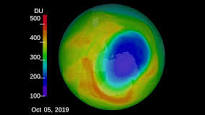Ozone Hole: Smallest on record
NASA reported that ozone hole near south pole is in its smallest size since it was discovered. In 2006, the hole was 10.3 million square miles. However, recently it has reduced to 3.6 million square miles. Scientists say that the hole is smaller than it was found in 1985.
Every year, the ozone hole reaches its peak in September and October and disappears by late December.
Significance
Earth’s ozone layer shields life from harmful solar radiation. The man-made chlorine compounds that can last in air for 100 years nibbled at the Ozone particles. This led to thinning of the Ozone layer in the Southern Hemisphere.
After it was found in 1985, the International Montreal Protocol was framed in 1987. It is the only protocol ratified at the United Nations that bans chlorine compounds in refrigerators and aerosols.
Unfortunately, the reason for the reduction of ozone hole is not the steps to reduce the usage of chlorine compounds. It is because of climate change.
Climate Change-a Reason
Chlorine in air requires cold temperatures in stratosphere to form chemical clouds that actually react with ozone. The clouds now go away as they are being warmed up due to elevated temperatures. The temperatures were 29 degrees warmer than the average. The winds dropped from 161 miles per hour to 67 miles per hour.
Though Climate change is the sole reason, it is being hastened by global warming. The Southern Polar Vortex just like the northern one started to break down. This is the main reason for the sudden and huge reduction in ozone hole.
Month: Current Affairs - October, 2019


